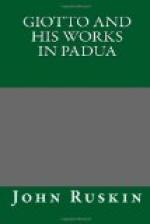This is evidently nothing more than a very vapid imitation of the scriptural narrative of the appearances of angels to Abraham and Manoah. But Giotto has put life into it; and I am aware of no other composition in which so much interest and awe has been given to the literal “burnt sacrifice.” In all other representations of such offerings which I remember, the interest is concentrated in the slaying of the victim. But Giotto has fastened on the burning of it; showing the white skeleton left on the altar, and the fire still hurtling up round it, typical of the Divine wrath, which is “as a consuming fire;” and thus rendering the sacrifice a more clear and fearful type not merely of the outward wounds and death of Christ, but of his soul-suffering. “All my bones are out of joint: my heart is like wax; it is melted in the midst of my bowels."[15]
[Footnote 15: (Note by a friend):—“To me the most striking part of it is, that the skeleton is entire (’a bone of him shall not be broken’), and that the head stands up still looking to the skies: is it too fanciful to see a meaning in this?”]
The hand of the Deity is seen in the heavens—the sign of the Divine Presence.
* * * * *
V.
THE ANGEL (RAPHAEL) APPEARS TO JOACHIM.
“Now Joachim being in this pain, the Lord God, Father of mercy, who abandons not his servants, nor ever fails to console them in their distresses, if they pray for his grace and pity, had compassion on Joachim, and heard his prayer, and sent the angel Raphael from heaven to earth to console him, and announce to him the nativity of the Virgin Mary. Therefore the angel Raphael appeared to Joachim, and comforted him with much peace, and foretold to him the birth of the Virgin in that glory and gladness, saying, ’God save you, O friend of God, O Joachim! the Lord has sent me to declare to you an everlasting joy, and a hope that shall have no end.’... And having finished these words, the angel of the Lord disappeared from him, and ascended into the heaven.” (MS. Harl.)
The passage which I have omitted is merely one of the ordinary Romanist accounts of the immaculate conception of the Virgin, put into the form of prophecy. There are no sufficient details of this part of the legend either in the Protevangelion or Gospel of St. Mary; but it is quite clear that Giotto followed it, and that he has endeavoured to mark a distinction in character between the angels Gabriel and Raphael[16] in the two subjects,—the form of Raphael melting back into the heaven, and being distinctly recognised as angelic, while Gabriel appears invested with perfect humanity. It is interesting to observe that the shepherds, who of course are not supposed to see the form of the Angel (his manifestation being only granted to Joachim during his sleep), are yet evidently under the influence of a certain degree of awe and expectation, as being conscious of some presence other than they can perceive, while the animals are unconscious altogether.




